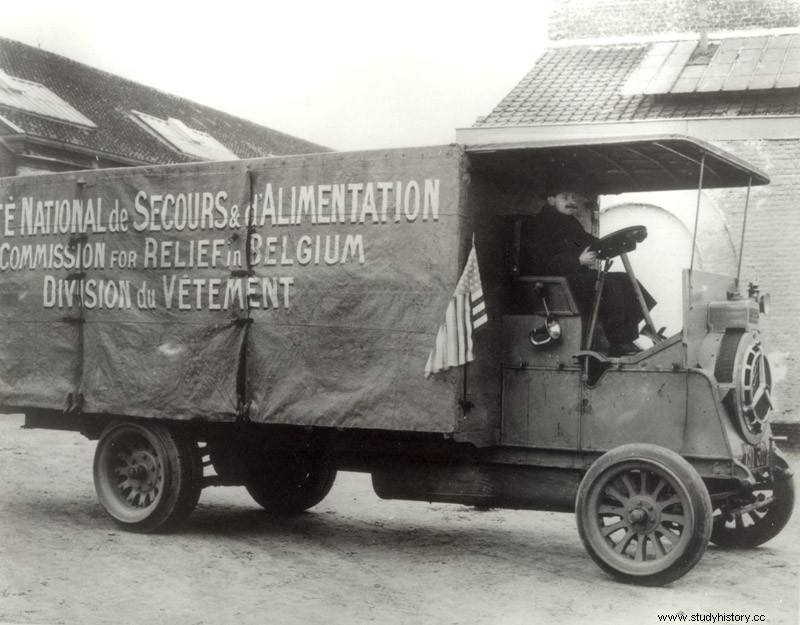The European Recovery Program , commonly called Marshall Plan by United States Secretary of State George Marshall, it was the most important plan for the reconstruction of European countries after World War II, which was also intended to contain a possible advance of communism throughout Europe. But it was not the first time that the United States helped European countries during a war. In 1914, during World War I, the Germans invaded Belgium and Luxembourg, but were stopped on the French front. After several clashes between the different contenders, the fronts stabilized without considerable progress.
That global disaster caused many Americans to flee the old continent to London and from there to return home. When they arrived in the British capital, their problems had not ended:it was difficult to find a ticket for the ships that crossed the Atlantic, it was almost impossible to find accommodation and, to top it off, the banks did not redeem the traveler's checks nor did the establishments accept them as a means of payment. of payment. But they were lucky that in those years an American businessman and mining engineer named Herbert Hoover lived in London. . Hoover, along with other possible compatriots, decided to join forces and raise money to get them lodging and exchange their checks for cash and be able to buy the tickets. They managed to bring home thousands of Americans. After the success of that operation, due solely to the efforts of private solidarity, the US ambassador to the United Kingdom, Walter Hines Page , he contacted Hoover to propose a larger action:to get food supplied to Belgium. The invasion of the Germans, the requisition of the scarce harvests of an eminently urban country and the blockade of the British caused Belgium to literally starve to death. On October 22, the Commission for Relief in Belgium was born. or CRB (Belgian Relief Commission).

Herbert Hoover
To succeed in this complex operation, the CRB had to be able to negotiate directly with the British and German governments as if it were its own state. Without your consent, nothing could be done. They managed to sign an agreement with the British government to allow them to bypass the blockade and with the German government to be able to distribute the food to civilians, as well as diplomatic immunity for Hoover and the CRB workers, all volunteers, to cross the borders. For the financing of that great company, collections were made in several countries, there were massive private donations and the allied governments also participated. With the money collected, wheat and other foods were bought in the American continent and Australia; The supplies were loaded onto the fleet of ships provided to the CRB that had to pass through the British blockade and the surveillance of German submarines until they reached the free port of Rotterdam (Holland). From there, and in trucks, they would arrive in Belgium to be distributed in the cities and towns.
What was initially going to be a specific solidarity operation had to be extended over time and to the occupied area of France. In 1917, Hoover estimated that almost three million people were being fed by the CRB through the more than two thousand local charitable committees created in Belgium and France to distribute the food. In addition to the problems of such a complex operation and in the midst of a war, the CRB had to overcome innumerable obstacles and no less criticism, even from the allies. Churchill led a campaign against this organization, considering that his intervention was prolonging the war by providing food to the Belgians and, in this way, the Germans did not have to worry about feeding the inhabitants of this country or quelling possible revolts caused by the war. famine.

And Hoover's solidarity operations would not stop here. When the United States entered the conflict in 1917, Hoover returned to his home and took charge of the United States Food Administration. But there is more:on December 6, 1917, when Finland became independent during the Russian Revolution, a brutal civil war broke out between conservatives and communists. Years of war, poor harvests and the Russian blockade caused a terrible famine in Finland and the Finns asked Hoover for help. Even with the CRB up and running and taking up his new post in the United States, he still had time to create the Finnish Relief Fund (Finnish Relief Foundation). Hoover raised funds in the United States and obtained food donations from there (90 percent) and also from Denmark, England and Norway to alleviate the Finnish famine. In total, more than thirty-five million meals reached Finnish children. And is it already? No. In 1939, the Russians invaded Finland to regain ground lost in 1917, and again they turned to Hoover. And he answered again… he managed to raise four hundred thousand dollars in the United States in just one month; by March 1940 he had secured two and a half million dollars in aid.
A small detail that I forgot, Herbert Hoover was president of the United States from March 4, 1929 to March 4, 1933.
